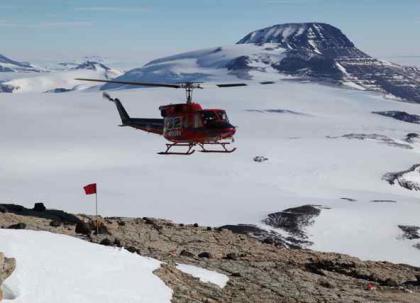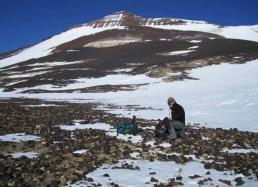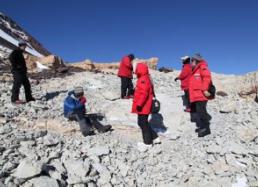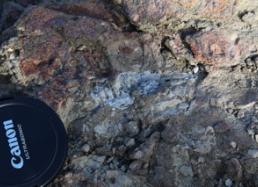6: More Dinosaurs at Mt. Kirkpatrick
On Monday morning, the entire team headed up in three separate helicopter flights to the Mt. Kirkpatrick dinosaur quarry site. At an altitude of nearly 12,500 feet—and with low pressure occasionally making it feel more like 14,000 feet—the dinosaur site is nearing the maximum altitude at which our helicopters can safely land, so keeping the total weight light on each flight is critical. In addition to ourselves, our packs, and any equipment, we also have to take survival bags with us each trip, which can be pretty hefty (around 60-70 lbs).
Peter Braddock and I (Nate) arrived first and began shuttling our gear over to the main quarry as the rest of the team was dropped off (see Photo #1 below.) With the air so thin, even walking short distances while lugging a rock saw or jackhammer is enough to leave you short of breath. This proved to be extremely lucky, however, because as team member Eva Koppelhus stopped for a moment to rest her pack on a large boulder, she spotted a small portion of a fossil rib sticking out of the side of the rock! The exposed end of the rib was well preserved and light gray in color, very similar to the bone that has been recovered from the Cryolophosaurus quarry (see Photo #2).
We quickly went to work setting up the generators and electric jackhammers that we’ll use to chip away at the rock in the main quarry, and Peter Braddock headed down slope to prospect for any bones from the quarry that had weathered out of the site previously. Peter’s keen eye paid off, and he returned with several fragments of bone that included two partial vertebrae from Cryolophosaurus. These could be identified by distinct quartz infillings within the neural canals (the hollow portion of the vertebrae that the spinal cord would have extended through in life).
The new generators handled the cold and thin air extremely well, and Pete Makovicky and Phil Currie began clearing the quarry of debris and breaking up the matrix encasing the bones of Cryolophosaurus. Josh Matthews and I fired up a rock saw that is older than I am (Nate Smith–1980; Stihl rock saw–1977; insert gratuitous product placement here) to begin removing large blocks from Eva’s new find.
Chipping away at the rock, we discovered several other ribs strewn throughout the large boulder. It was obvious that this boulder had fallen down from somewhere slightly higher on the mountain, but not from the same exact level as the main dinosaur quarry. This meant that we probably had a new dinosaur specimen on our hands, although it will take a lot more work to figure out whether it is another specimen of Cryolophosaurus, or something entirely different. Hopefully the boulder contains additional bones that will be more informative that the ribs alone.
Chris, Roger, and Adam also continued to meet with success in the Middle Triassic rocks on Fremouw Peak, finding a toothy amphibian jaw nearly as long as a person’s lower arm (see Photo #3 below.) Coupled with the finds from Saturday and the surprising success of our new generators and jackhammers, the expedition was off to a very exciting and productive start.
Cheers,
Nate








